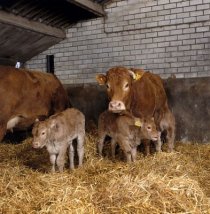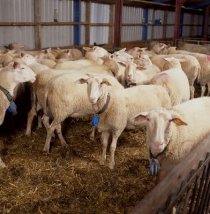Fly control in animal housing and confinement
Effective fly control does not only target the fly on the animal, when the animals are being kept in stables. Animal production sites, stables in general are favoring fly reproduction. The consequence of not taking fly reproduction and factors influencing it sufficiently into consideration will be a heavy fly infestation in the livestock or poultry production site.
Measures of successful fly control don’t involve only the treatment of the animal with an insecticide it must consider as well the developments in animal production and animal housing. Animal husbandry practices, especially housing and manure-handling systems are important factors for successful fly control.
In the following chapters we will explain important actions which help to decrease the fly population in animal houses and environment. These actions are therefore an important part of an integrated fly control program, together with the application of insecticides on to the animal and surfaces/walls.
Fly Reproduction
The number of flies in an animal housing system is determined by environmental factors such as temperature, moisture of breeding habitat and humidity in the facility and natural enemies including parasites, predators and pathogens.
Fly populations can reach unacceptably high levels in and around confined animal production facilities when the following factors are not being taken additionally into consideration:
- Macroclimate
- Microclimate
- Manure Management
Factors Affecting Fly Reproduction
Macroclimatical Conditions
The climate of an area serves as an overall indicator of the potential level that fly population may reach. However, confined-animal production facilities greatly change the environment.
On grazing pasture, predators have a significant role in regulating fly population levels. However, the concentration of animals and manure in industrial animal production facilities creates an unnatural situation.
The overall temperature range and summer temperatures in a region are indicators of how fast flies will develop and how many generations per year there will be.
The fly season in the northern hemisphere generally increases from north to south, according to the different climatic zones. The higher the temperature and the longer the season with high temperatures, the quicker is fly development and the greater will be the number of fly generations per year.
Nonetheless, any confined animal housing will alter the situation significantly, because it creates an artificial environment. Due to this reason, even more fly generations per year are likely to occur in and around confined-animal housing than the climatic zones would allow.
The temperature maintained in the stable system will influence the fly population level much more than the outside climate of the region.
Microclimate Conditions
The microclimate of the breeding medium is also one of the major factors in determining the rate of fly development and level of fly infestation.
Accumulated manure and other fly-breeding favoring organic material (silage, hay, feed) causes heat due to their fermentation. Therefore, the temperature in the breeding medium is considerably higher than the surrounding air (whether indoors or outdoors).
The higher the manure quantity, the higher is the temperature increase. A greater range of temperatures provides fly larvae better opportunities to find a suitable habitat for their development.
During the winter in cold northern areas fly larvae development slows down, and longtime survival of pupae routinely occur indoors in confined-animal facilities. The same occurs outdoors in piles of manure, silage and hay.
During summer, the fly reproduction rate in accumulated manure or other breeding medium is often faster than expected from weather data. Confined-animal housing and a concentration of manure and feed create an artificial environment, protected against the weather and in favor to fly breeding.
Since confined-animal production is an artificially created by humans, it can be manipulated in a way to either encourage or discourage fly breeding. Preventive measures like the coverage and protection of feed (silage, hay bales, grain) from moisture, and minimizing fermentation provides a less favorable habitat for fly reproduction. Farm management practices in this regard are major factors in determining fly abundance.
Manure Management
Manure management is a major factor in controlling fly reproduction. Two ways of manure management exist: frequent manure removal and prolonged manure accumulation.
When manure is completely removed frequently, there is no medium for fly breeding in the animal facilities.
As an alternative, manure is allowed to accumulate and is regularly trampled and compacted, it becomes an unsuitable medium for fly breeding.
Regular Manure Removal
If manure is being removed with flushing and/or scraping systems every day or two, most fly breeding can be eliminated with frequent cleaning.
However, with these systems it is common to leave manure pockets which support fly breeding. Fences, corners, edges and areas under railings are missed by the equipment. Low water pressure or broken scraper cables cause these automatic systems sometimes to fail, or do an incomplete job of manure removal. Crusting and caking of manure causes accumulations that cleaning equipment cannot remove any more.
Daily or very frequent manure removal leads to the problem of manure disposal. If the manure is spread immediately on fields in a uniform thin layer, fly breeding will not be possible. Nonetheless, if the manure spreaders leave large clumps, then breeding might occur. Manure spreading can be facilitated by adding water, although this may create odor problems.
Other options for disposal are to pile the manure or flush it into a deep lagoon for anaerobic decomposition.
Fly breeding in piles of manure can be avoid when pile is compacted and covered (for example with plastic sheeting), causing high temperature in the pile, too high for fly survival.
A properly designed and managed lagoon will not breed flies. However, if the lagoon is overloaded with too much manure for its size, there may be floating mats of manure and debris which will support fly breeding.
An alternative to disposal by flushing into an outside lagoon is flushing into a pit containing water beneath the floor of the animal housing. This method is commonly used in slotted-floor swine houses. Periodically the pit has to be flushed or pumped out into an outside lagoon or spread on the fields.
Manure Accumulation
The other way to regular removal is to allow manure to accumulate for longer periods of time.
If manure is regularly compressed and trampled by large livestock, the medium will become unsuitable for fly breeding.
In poultry production (caged-layers and breeders) manure is often allowed to accumulate for a year or more. In this situation, if the manure dries sufficiently, fly breeding will be limited.
Many species of parasites and predators found a perfect habitat in accumulated manure. They attack fly eggs, larvae, or pupae and significantly help in reducing fly numbers.
With accumulations of manure, the degree of airflow and protection from moisture (rain, drainage, and leaking animal drinking tanks) become of major importance because the drier the manure, the less suitable it is for fly breeding.
Between extremes – Periodic Manure Removal
Periodic (sometimes erratic) manure removal is often a part of procedures alternative to either regular manure removal or manure accumulation. Stable and feedlots design dictates how well manure removal can be accomplished and how often it is practical to execute.
If no automatic equipment is involved, removal has to be with hand-tools and tractor-mounted loaders and scrapers. The frequency and completeness of manure removal using these methods is important to an integrated fly management program.
It is difficult, if not impossible, to execute a successful fly control program if the manure management program is erratic and unplanned.
If manure is allowed to accumulate for long periods or for periods of irregular length, populations of manure-inhabiting predators and parasites build up.
Total removal of all manure in one short period of time will also remove most of the beneficial insects and mites.
Therefore, staggered partial removal over a period of 2-4 weeks is preferable to total removal within a short period of time.
Species Competition
An additional factor affecting the number and composition of a fly population is the competition among and between different fly species.
The most notable example is the black soldier fly, Hermetia illucens. Its large larvae churn manure and render it physically less suitable for the survival of other fly larvae species, and for egg-laying by house flies and other muscoid flies. The slow development of soldier fly larvae results in large numbers accumulating in manure.
The black soldier fly may become extremely abundant in poultry manure (especially in high-rise or deep pit houses), and in swine manure pits; in these types of confined-animal housing it may become the major fly species.
Another fly species important in competing with the house fly is the black garbage or dump fly (Ophyra spp) whose larvae prey on other fly larvae. Ophyra, like soldier flies, sometimes become very abundant in poultry and swine housing.



